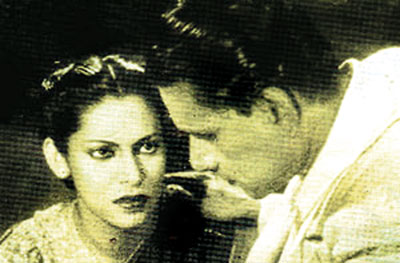70 years ago we all flocked to see‘Kadawunu Poronduwa’
 Seventy years ago…
Seventy years ago…
Year: 1947
Month: January
Date: 21
Venue: Kingsley Theatre, Kotahena
Event: First Sinhala film is screened under the patronage of senior minister D.S. Senanayake and Mrs.Senanayake.
The film was an adaptation of a popular Sinhala drama, ‘Kadawunu Poronduwa’ (Broken Promise) by the Minerva Theatre Group in Negombo headed by B. A.(Aloy) W. Jayamanne. He wrote and produced the drama–the second in a series of several others with titles based on the English alphabet in order. (‘Apparition’ –‘Avatharaya’ in Sinhala was the first and the third was ‘Changing Fate’ – ‘Peralena Iranama’). He also did the screenplay and was the main actor as well. The same title was retained for the film. The players were those who had acted in the play – none had any experience in facing a camera.
The film was the result of the initiative taken by a South Indian entrepreneur, S.M. Nayagam who broke into the celluloid world to produce his maiden film. Obviously he saw the potential for a Sinhala film as the Tamil and Hindi films were drawing crowds though the vast majority of the local filmgoers could not understand either language. Seeing the success of the Minerva dramas he succeeded in getting BAW to agree to a film version of one.
Nayagam set up a company – Chitralekha Movietone with Ceylonese directors and built a studio in Madurai. The technical crew comprised Indian personnel. The cast moved to Madurai for the filming which was totally done inside the studio.
The film was completed in six months. It had cost a little over Rs. two million. The cast consisted of 16.
Nayagam would naturally have had to depend on BAW to assist in production work. Having done the story, dialogue and screenplay, BAW had to train the actors as well. Studying the filming operation carefully he used the experience gathered to direct several films based on other Minerva plays and other stories like W.A.de Silva’s popular novel, ‘Kele Handa’.
With his experience BAW is reported to have outlined the basics of a Sinhala film. It should run for at least two and a half hours. One hour for scenes with dialogues; half an hour for songs (minimum ten songs); half an hour for silent background scenes; fifteen minutes interval. (Still many producers seem to be following this formula !)
I remember seeing the film at the Kingsley Theatre with friends. We really didn’t watch it with a critical eye. As students at Ananda we often used to go to New Olympia to see an English film or to Gamini (it was burnt down during the1983 communal riots) for Hindi films. We never missed a Hindi movie with Dilip Kumar, Raj Kapoor, Dev Anand, Ashok Kumar or Bharat Bhooshan, all of whom acted with Nargis, Madhubala, Kamini Kaushal, Nimmi or Vyjayanthimala. They were the leading stars of Bollywood (the name was coined much later) of the day. We saw Dilip Kumar occasionally running round a tree singing a song or Raj Kapoor and Nargis in a romantic scene suddenly bursting out into a song. We didn’t bother – we enjoyed their acting as well as the music by either Naushad or Shanker/Jaikishan with playback singers Mukesh (he often sang for Dilip Kumar), Mohamed Rafi and Lata Mangeshkar lending their voices.
Rukmani Devi was the main attraction in ‘Kadavunu Poronduwa’. She was, by then, a melodious singer and a seasoned stage actress. As the leading actress of the film, she sang six of the twelve songs. I remember at least one scene where she sang ‘Jeevithaye Saame’ playing the piano while the husband-to- be admired her singing. Being the gramophone era all the songs were released as 78rpm records. ‘Sandyavesreeyaramyalesapena’ and Yamiindiyadesata’ were among the other songs which became popular.
The film began with a patriotic song while the titles appeared on the screen. She was the lead singer in the chorus.
Eddie Jayamanne in his comedy role as Manappu, the odd job man in the house, with Jemini Kantha (Josie), the kitchen maid, kept the audiences laughing. Eddie’s solo, ‘Lapatirupe’ describing the maid’s beauty, ‘Kolom pure sriya’ on the busy Colombo city, and a duet with Jemini K – ‘TakkitaTrarikita’ were instant hits and are being sung till today. Lyrics were written by Hugo Fernando (Hugo Master), a seasoned stage actor who ultimately had a long career in cinema. The music director was Narayana Aiyar.
Apart from the comedy duo, others conversed more in what can be termed the ‘written’ language than the simple spoken word.
Playing key male roles were BAW, Peter Peiris and Stanley Mallawaarachchi. They wore double-breasted suits most of the time. Bertram Fernando, to an extent, imitated Eddie J in the light role he played.
The film was directed by Jyotish Singh and edited by Pakeer Saleh. Camera was handled by K Prathaka.
The film was released to two other cinemas in Colombo – Mylan in Pettah and New Olympia. Being a landmark event in Sri Lankan cinema, crowds went to see it irrespective of quality.
It was obvious we had a long way to go. It was after nine years and 42 films that a real Sinhala film hit the screen – none other than ‘Rekava’!


